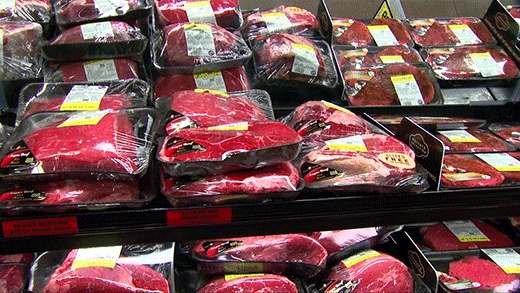Meat lovers take notice: You don’t have to sacrifice juiciness when cooking your steak to higher temperatures.
That’s a key finding by Kansas State University graduate student Lindsey Drey, who put consumers through a series of test panels with four USDA quality grades of meat and six degrees of doneness.
“We all know that when we cook steaks very well done that they are going to lose moisture,” said Drey, whose work is part of a thesis that she will complete this May. “But the marbling, the added intramuscular fat, in higher quality steaks helps to counteract those negative impacts and make the steak acceptable for juiciness.”
Consumers will recognize marbling as the small white flecks in meat products, which is more prominent on higher quality grades such as USDA Prime and Top Choice.
“The idea of protection or ‘insurance’ that marbling provides against overcooking has long been theorized (but) this work was the first to put it to the test,” said Travis O’Quinn, assistant professor and meat scientist who oversaw Drey’s study. “Our results provide solid evidence as to the impact marbling has on beef cooked to elevated degrees of doneness and can provide consumers who prefer these degrees of doneness an idea of what level of beef quality they should look for in order to have the best eating experience possible.”
In Drey’s study, USDA Prime and Top Choice fared well in consumers’ ratings of juiciness acceptability, even when the steaks were cooked well done or very well done.
“It appears that as we cooked those steaks to extreme temperatures, marbling counteracted the negative impact that the increased degree of doneness had on those steaks,” she said.
Two other quality grades—USDA Select and Low Choice—had a sharp decline in acceptability ratings when the steaks were cooked medium, well done or very well done.
“What’s cool about this data is that they all are pretty acceptable up until medium rare,” said Drey, who will graduate in May with a master’s degree in animal science. “Once you go past medium rare, you get a sharp decline in the steaks that are still rated acceptable.”
More marbling in meat, however, does equate to more fat in the meat so consumers often bypass the higher quality grades in favor of more lean meats. But when consumers prefer to have their meat cooked to higher temperatures, Drey said Prime and Top Choice cuts will improve their eating experience.
“Even when the Prime steak is cooked very well done, you have the possibility of having a better eating experience than those lower grades cooked to well done,” she said.
For consumers who like their steaks cooked very rare, “it doesn’t matter what you buy,” Drey said. “The consumer panels indicated that you can buy the cheaper steak and you’re still going to have a good eating experience for juiciness.”


